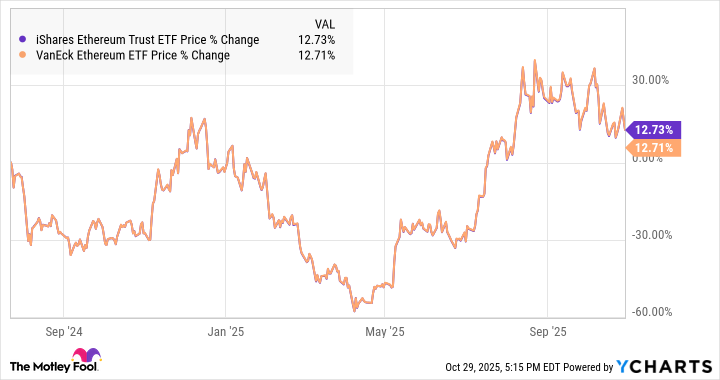Both the iShares Ethereum Trust ETF (ETHA +0.87%) and VanEck Ethereum ETF (ETHV +0.88%) aim to mirror the price of Ether (ETH 4.35%), making them straightforward options for those seeking direct crypto exposure in an ETF wrapper. This comparison covers cost, recent returns, portfolio design, and trading details to help clarify where these two funds diverge.
Snapshot (cost & size)
| Metric | ETHV | ETHA |
|---|---|---|
| Fund name | VanEck Ethereum ETF | iShares Ethereum Trust |
| Issuer | VanEck | IShares |
| Expense ratio | 0.20% | 0.25% |
| 1-yr return (as of Oct. 27, 2025) | 67.5% | 67.1% |
| Beta | 4.53 | 4.52 |
| AUM | $272 million | $16.8 billion |
Beta measures price volatility relative to the S&P 500; figures use weekly returns for the life of these funds, both of which started on July 26, 2024.
ETHV is more affordable on fees, with a 0.20% expense ratio versus ETHA's 0.25%. ETHA, however, commands significantly larger AUM, which may appeal to those prioritizing fund scale and liquidity.
Performance & risk comparison
| Metric | ETHV | ETHA |
|---|---|---|
| Max drawdown (5 y) | (64.02%) | (64.02%) |
| Growth of $1,000 over 5 years | $1,168 | $1,166 |
Data taken from YCharts on Oct. 29, 2025.
What's inside
ETHA delivers single-asset exposure to Ether, with 100% of holdings in the Financial Services sector. The portfolio holds Ether (a.k.a. Ethereum) a small amount of USD cash (about 0.0003% of the portfolio as of this writing), and has been on the market for about 1.3 years (as of Oct. 28, 2025). There are no leverage, currency hedge, or ESG quirks to consider. The fund’s tight focus means performance should track Ether closely, though it is not registered under the Investment Company Act of 1940.
ETHV is also a pure-play Ether vehicle, holding only Ether and cash. Its sector breakdown is not reported, but works out to only Financial Services. The structure is similarly straightforward, with no added strategies or overlays. Both funds offer direct Ether price exposure, but ETHV’s smaller AUM could affect liquidity for large trades. Its cash holdings are also larger, relatively speaking, but that's still essentially a rounding error at 0.02% of AUM.
For more guidance on ETF investing, check out the full guide at this link.
Foolish take
There are very few differences between these two funds. If a large portfolio with ample trading liquidity is important to you, ETHA should be the obvious choice. To optimize your Ethereum holdings for minimal fees, ETHV makes more sense. The differences are minimal, though.
You could make a nitpicky case about the VanEck fund having a slightly larger cash position, but that's not a significant issue. Both funds only hold enough cash to facilitate their management of Ethereum tokens -- standard operating procedure for any exchange-traded fund.
You could also skip both of these names and invest in Ethereum directly, if you prefer. That's the best way to minimize annual fees, which aren't a thing in crypto-trading accounts. On the other hand, you lose the easy account management that comes with the ETF structure, and may need to open a new account with a crypto exchange in order to get started.
For most long-term investors, all three options should serve you well -- assuming that Ether prices go up in the long run. That seems like a reasonable assumption for the second-largest cryptocurrency and leading smart contracts platform, but the crypto sector is inherently risky and volatile. Make sure to keep your crypto positions small enough that you could afford them going to zero someday -- just in case. That includes Ether itself, as well as the ETHA and ETHV funds.

Glossary
ETF (Exchange-Traded Fund): A fund traded on stock exchanges, holding assets like stocks, bonds, or commodities.
Expense ratio: The annual fee, as a percentage of assets, that an ETF charges investors for management and operating costs.
Assets Under Management (AUM): The total market value of assets an investment fund manages on behalf of investors.
Beta: A measure of an investment's volatility compared to the overall market; higher beta means greater price swings.
Max drawdown: The largest observed loss from a fund's peak value to its lowest point over a specific period.
Liquidity: How easily an asset or fund can be bought or sold in the market without affecting its price.
Pure-play: An investment focused solely on a single asset, sector, or strategy, without diversification.
Leverage: The use of borrowed money or financial derivatives to increase the potential return of an investment.
Currency hedge: A strategy to reduce the impact of currency exchange rate fluctuations on investment returns.
ESG: Environmental, Social, and Governance; criteria used to evaluate a company's ethical impact and sustainability practices.
Investment Company Act of 1940: U.S. law regulating investment funds to protect investors through standards and disclosures.


